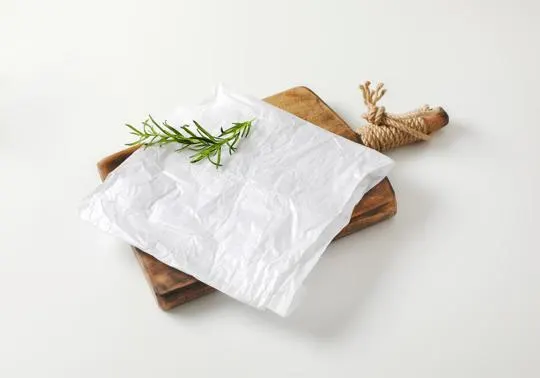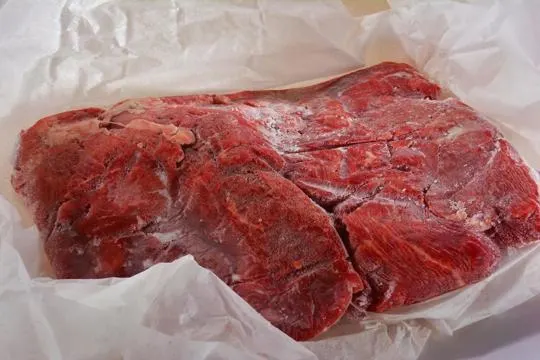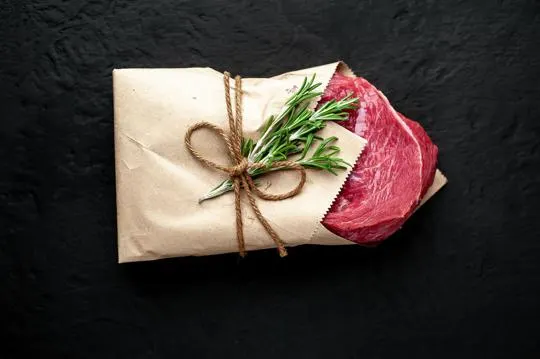Summary of key points
The main difference between freezer paper and butcher paper is in their respective coatings. Freezer paper has a plastic or wax coating on one side, making it moisture-resistant and suitable for freezing food items. Butcher paper does not have any coating and is primarily used for wrapping meat or lining trays.
In terms of functionality, freezer paper can withstand long periods of time in the freezer without becoming soggy, while butcher paper is not suitable for freezing and can become wet easily.
Both types of paper are often used in cooking, but freezer paper has the added benefit of being able to double as a surface for crafting or protecting surfaces during messy projects.
Ever stood in front of the wrapping aisle, feeling utterly bemused? We’ve all been there.
Freezer paper and butcher paper seem like twins separated at birth. Yet, a closer look reveals they’re more like distant cousins. We learned this the hard way during our annual BBQ extravaganza.
In that chaos, we found out these papers serve different masters.
Freezer paper, glossy on one side, is a champ at preserving our favorite meats in the cold abyss of our freezers. Meanwhile, butcher paper, with its breathable nature, keeps our briskets juicy and tender while they smoke.
It’s not just paper; it’s a lifestyle choice.
What is Freezer Paper?

Freezer paper is a heavy-duty paper with plastic on one side. It’s designed to preserve food in the freezer.
The plastic prevents moisture and air from entering, keeping food safe from freezer burn.
Meat wrappers use freezer paper.
The plastic-coated side stops juices from leaking through.
It’s durable and tear-resistant, too. You can also label or write on it.
Artists and crafters use freezer paper. Its shiny surface is ideal for stencils and templates.
Heat an iron to stick it in place. Butcher paper doesn’t have plastic coating.
It’s used for fresh meats, but it doesn’t insulate like freezer paper does.
What is Butcher Paper?

Butcher paper, also known as steak paper or peach paper, is a type of kraft paper.
It’s treated with an FDA-approved coating that prevents liquids and oils from soaking in.
This paper is usually white or pink in color. The U.S. tends to use more pink.
Butcher paper is very versatile. Use it to wrap meats, cover cutting boards, line trays, or even as a surface for art projects.
The thick and durable texture resists tears and punctures.
Unlike plastic wrap or aluminum foil, butcher paper allows air to circulate around the food.
This helps maintain quality and flavor by preventing moisture and staleness.
Butcher paper adds a professional touch to any presentation or display.
Whether it’s for a backyard cookout or a restaurant, it looks great and keeps food fresh and protected.
Differences Between Freezer Paper and Butcher Paper

Freezer paper and butcher paper have different uses in the food industry.
Composition and Coating
Freezer paper and butcher paper have distinct compositions and coatings.
Freezer paper is usually made of polyethylene for strength and durability.
It has a wax or plastic coating on one side, allowing for easy sealing and protecting against moisture.
Butcher paper is chiefly kraft paper – a type of heavy-duty brown paper.
It has no coating or wax layer.
This makes it breathable, allowing air circulation around food for freshness.
Freezer paper is special as it can stand low temperatures without going brittle or losing integrity.
It stays strong even when in contact with frozen food for long periods, making it great for freezer storage.
Butcher paper is amazing at handling high temperatures.
It’s great for smoking meats, or for a disposable BBQ table cover.
Its heat resistance guards the meat from too much heat while letting in smoke for flavor.
To summarize, freezer paper and butcher paper have different functions but their composition and coating are what set them apart.
Freezer paper is polyethylene and wax/plastic for low temp storage.
Butcher paper is breathable and lacks coating, for wrapping fresh cuts of meat at higher temps.
Purpose and Usage
Freezer paper and butcher paper have distinct purposes and uses.
Freezer paper’s plastic coating gives a protective barrier against freezer burn.
It’s perfect for wrapping food items for long-term storage.
Butcher paper is durable and breathable.
It has many uses like wrapping fresh meats, lining trays during food prep, and even crafting projects.
It offers versatility without sacrificing quality.
These differences let users pick the best choice for their needs.
Temperature Resistance
Freezer paper and butcher paper both have differing temperature resistances.
Freezer paper’s purpose is to withstand intense cold temperatures, making it ideal for storing food in freezers.
It guards against freezer burn, staying intact and guarding against moisture and air.
Butcher paper may not be suitable for freezing temperatures.
It may become brittle or lose its protection when exposed to extreme cold.
When selecting between the two, freezer paper is the right choice for freezing temperatures.
It keeps food fresh and prevents freezer burn.
Butcher paper is useful for non-freezing conditions, such as wrapping meat or lining surfaces during cooking.
Ultimately, freezer paper is superior for handling extreme cold, while butcher paper is great for mild temperatures.
Use freezer paper when needed for cold storage and butcher paper for all other purposes.
Permeability to Air and Moisture
When deciding between freezer paper and butcher paper, permeability to air and moisture is essential.
Both types of paper have different degrees of impermeability, affecting the freshness and quality of stored food.
Freezer paper is made for use in freezing food.
It is impermeable to both air and moisture, keeping food fresh and secure.
This is due to a special coating on one side of the paper that forms a barrier.
Butcher paper has a slightly lower level of impermeability than freezer paper.
It provides some protection against air and moisture, yet may not be as effective for long-term storage or freezing.
Butcher paper is typically used for a shorter period of time, like wrapping meats in butcher shops or barbecuing.
A noteworthy characteristic of these papers is that freezer paper is thicker and more durable than butcher paper.
This additional thickness provides extra insulation and protection against outside factors that could hurt the quality of stored food.
Similarities Between Freezer Paper and Butcher Paper

Although freezer paper and butcher paper may seem like two completely different products, there are actually many similarities between the two.
Both types of paper are commonly used in the food industry and are known for their ability to preserve and protect food.
They are also made from high-quality materials that are durable and long-lasting.
Additionally, both freezer and butcher paper are versatile in their use, with applications ranging from wrapping meat to covering surfaces during meal prep.
While there may be some subtle differences between the two, such as the thickness and texture of the paper itself, the similarities between freezer paper and butcher paper are undeniable.
For anyone looking for a reliable and effective means of storing and protecting their food, both of these options are excellent choices.
Popular Uses of Freezer Paper and Butcher Paper
Freezer paper and butcher paper are great for various uses.
Each with unique features.
Freezer paper is perfect for food preservation.
It forms a tight seal, protecting food from freezer burn and keeping it fresh.
People also use it for wrapping and storing meats, blocking moisture and air.
Plus, for crafts and DIY projects, its smooth surface allows for easy drawing or stenciling.
Some even use it as a temporary adhesive.
Butcher paper is mainly used in the food industry.
Wrapping and storing meat products at grocery stores or butcher shops.
The quality of the paper helps to maintain freshness and allows the meat to breathe.
It’s also great as a disposable table cover at parties or events.
Many artists prefer it as an alternative canvas due to its durability.
Both freezer paper and butcher paper have their own unique properties.
Freezer paper works well for food preservation and crafting.
Butcher paper is best for the food industry and creative arts.
Knowing the differences helps individuals choose which type suits their needs.
What to Consider When Choosing Between Freezer Paper and Butcher Paper?
Choose between freezer paper or butcher paper? Consider these things:
- What you use it for. Freezer paper is for freezing and preserving food. Butcher paper is for wrapping and storing meat.
- How much moisture resistance needed? Freezer paper has a plastic coating, making it better for freezer storage. Butcher paper is less resistant to liquids and not best for long term freezer storage.
- Durability and strength? Freezer paper is thicker and sturdier. It can handle freezing temps without tearing.
Think about purpose, moisture, and durability when picking between freezer paper and butcher paper.
Conclusion
Throughout this article, we discussed the essential details of freezer paper and butcher paper.
From their various applications to the types of papers they are made of, it’s safe to say that these two have distinct similarities and differences from each other.
When comparing freezer paper and butcher paper for your specific needs, make sure you consider the temperature requirements, moisture retention rate, waterproof abilities, thicknesses, sizes, odorability, recycling options, cost-effectiveness as well as ease of use.
Most importantly though: know what purpose you have for either paper.
Although both are made with different materials and intended for different applications; one fact is certain – the product comparison between freezer paper vs butcher paper can be difficult to decipher.
With the myriad applications on which these two papers are used all across boardrooms and restaurant kitchens alike – or just in a backyard BBQ – it can easily become a taxing task choosing one over the other.
That’s why understanding all differences between freezer paper and butcher paper before making any purchasing decisions is key.

Leave a comment